
CATAMOUNT BITS IN TIME
Definitely Under
Construction...Nowhere Near Done.
This was one of the very first
pages on the site and I had big plans for it. I would still like to write up
the little anecdotal stories that best make up the tale of Catamount;, but I
don't have enough time right now.
-Bill

A Man Whose Career Defined Catamount
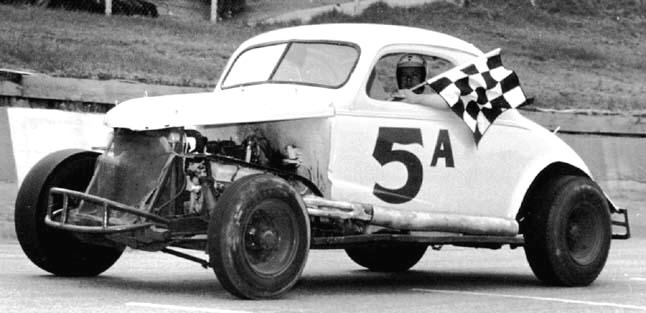
Courtesy of Cho Lee Burlington Free Press Photo - Mark Sasahara
Jean-Paul Cabana drove this white coupe to the very first feature win in Catamount history. Around 22 years later, he drove this state - of - the - art fiberglass - bodied car to the track's final feature win. This shot shows a caution during that feature.
It Could Only Happen With the Grace o' God
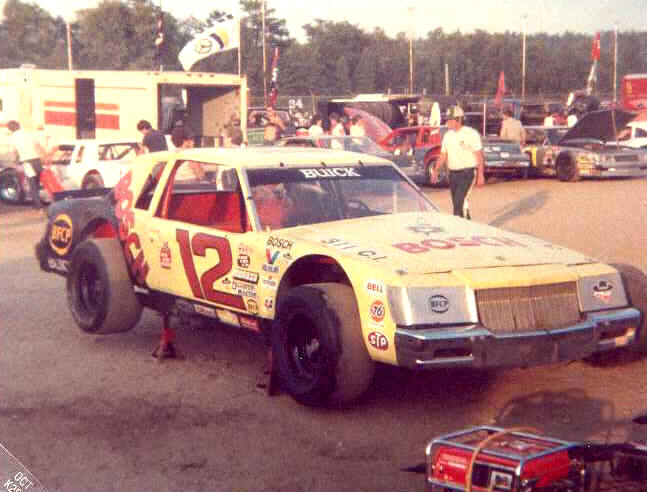 Courtesy of Darrell Rogers The C.A. Crouch Buick sits in the pits, under preparation for a race. This is the car Glaser drove that April afternoon. |
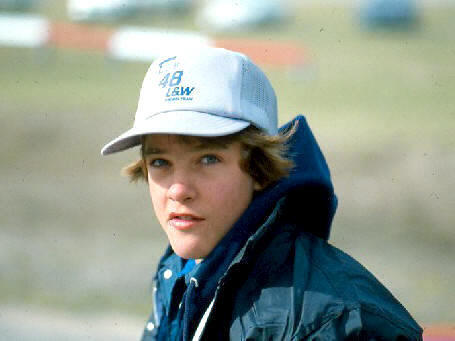 Photo Source - Mark Dean Ricky Crouch, right around the time of this story. |
The Spring Green was finally to feature a
second Crouch [or third, if you count C.A.]. Younger brother, Ricky was now old
enough to be put in the seat of the Crouch #36 car. The usual Spring Green hype
and spin was in place, and practice had been held in the none-too-warm Vermont
countryside. Tom Glaser was to spend the season in the other car, the #12.
The out-of-town teams either retired
to a motel or to some generous local's garage to make final preps on the car.
The locals headed home or to the headquarters of the racing team. Radio talk
shows buzzed away; parties were held - so, about every racing topic was covered
at one point or another. Expectation was high.... and that included the Ricky
debut.
Then, the following morning, the most
unbelievable news began to seep around. Ricky Crouch had somehow gone off the
interstate in his father's pickup, and was killed. The usually merry pre-race
activity in the Catamount pits was severely tempered by this news. People went
through the motions numbly, sadly.
The race community was heartened to
see the yellow #12 Chevy towed into the pits - the car that was to be Ricky's
team mate.
It was learned that former mini stocker Tom Glaser, a friend of the Crouch
family, was still driving the car, one that was somewhat familiar to him. To
make a long story short, Hollywood could not have made a better script. Glaser
ended up upsetting the entire field and winning the race - for C.A., Robbie, and
Ricky. There wasn't a dry eye in Victory Lane.
A Sad Ending to a Proud Track
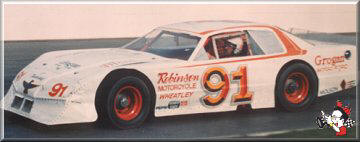
From the SOSCARS website
Russ Urlin, London Ontario - Catamount's final lap speed record holder.
I
make no bones about it - it rankles me to no end that the final record holder of
our beloved Catamount has to be someone we hardly knew. This only happened
because
ACT had gone to the plastic cars in 1987, and guys like Urlin were
far more experienced with the setup than the guys who had always run at
Catamount.
From the SOSCARS website
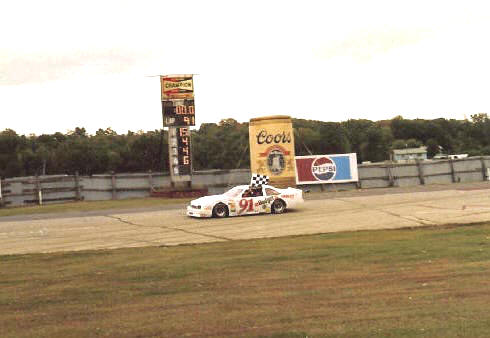
Courtesy of Mike Cain
Urlin taking the victory lap after setting the final lap speed
record at Catamount. Ironically, his car
number was the same as Catamount's favorite son, Beaver Dragon.
The Well - Traveled Hurricane Cars
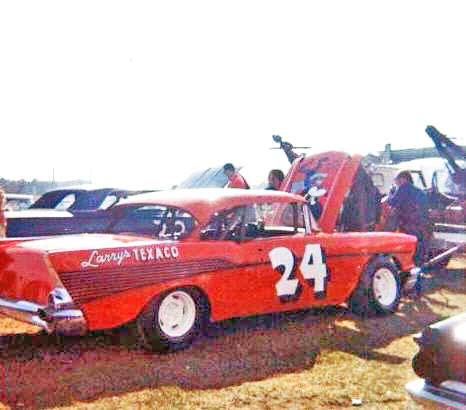 Bill Ladabouche Photo
The Larry Warren - built Hurricane sits under fine tuning in the Catamount pit area. |
|
|
The Hurricane Division was not yet very well established at Catamount when Larry Warren arrived on the scene. The division had not even enjoyed the name for all that long of a time, as it had started out being called The Night Riders, The Chargers, and a few other ill-conceived monikers, as well. The cars were nothing much to look at, although, in their second year of existence, they were a far sight more attractive than those original monstrosities that had lurched, bounced, and squealed around Catamount's third mile asphalt the first season.
Larry arrived with a low-riding 1957 Chevrolet around 1971. The first one was nothing to look at, but the Burlington driver soon put in some effort to make the car attractive. he picked up a sponsorship from Aunt Sara's Pancake House, on Shelburne Road...and he was off to the races ! The following year, the car was back, and it had been re-configured into a very impressive-looking hot rod. Warren became a serious threat to win every year.... and the car caught the eye of any dedicated Hurricane fan. Warren eventually tired of the whole thing and sold the car off. What came next was a remarkable string of owners for this most memorable Chevy. To name a couple, it was owned and run by future late model owner and Beaver Dragon L.E. Farrell crewman Rodney Weed - and it ended up in the hands of future Catamount star and Nascar North Champion Jamie Aube, for a brief spell. Very few cars hit more different owners than Larry Warren's orange Chevy with the Motor Mouse cartoon on the hood.
|
. Around 1972 with help from Jim Cayea, Leon Gonyo built himself a 1962 Plymouth for the Hurricane Division at Catamount. The powerful, thundering Mopars were now the car of choice in the division. Gonyo, who spent more time around Airborne Speedway than Catamount, knew that this car would get him more results than his more preferred Fords, at that time. Except for the tandem of Richard Buzzi and Dennis Tucker, Fords weren't doing much in the Hurricanes, at that time.
For whatever reason, Gonyo didn't stick around long, and he sold his car off to George Boudreau of Colchester, Vermont. This would begin a remarkable string of successful use and ownerships of this car. It had almost as many lives as a cat - by the time Hurricanes were no longer allowed. Boudreau would own the car twice, at two different times. Ironically, thecar at this time was almost always black and orange, which Gonyo would have originally have sued as his scheme. Other owners would include Jim Hogan [in between Boudreau's stints] and finally Don Turner, a hometown Catamount veteran who had started back in 1966 as the" Flying Milkman ". By the time Turner was down, the Hurricanes were being phased out. Don Turner, Jr. [who would grow up to be the majority leader in the Vermont legislature] would be the last driver of the car.
The car was built amazing sturdy and, despite its considerable weight, the
huge Mopar engine could propel it at very competitive speeds. As far as I
know, the car never visited Victory Lane; but it was always regarded as
one of the better cars in the division and it was always a threat to win -
if the division hotshots weren't careful. It is
now thought that possibly the car came from Jim Cayea, who also drove in
the Hurricanes and who constructed the first car [very similar to this
one] for the great Leon Gonyo.
The car, at full color when
Boudreau and |
|
We now think the last driver of
the car, at the very end of its |
Little John and Chester T.
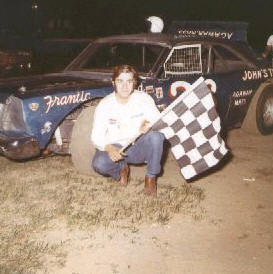
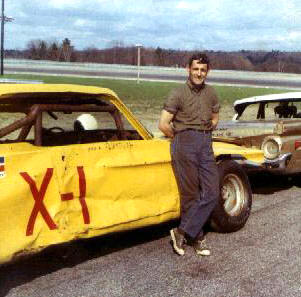
Photos Courtesy of Lloyd and Gregg Gilbert
Little John Rosati, from Agawam. MA Chester T. Wood, from Orange, VT
Here is a Story - an Excerpt From the Column North Country Thoughts :
A RUDE
AWAKENING
.......
The track saw the return of
Jean-Paul Cabana and Andre Manny - from Quebec. Rene Charland actually got
together with a Chevelle, although it was not particularly competitive. New York
saw a contingent of former coupe drivers return with Mopars, but they were not
very competitive either. Even Vince Quenneville, Sr. left Devil’s Bowl long
enough for an abortive try. In a nutshell - the locals had become pretty damned
good. The established Catamount stars, for the most part, remained the top
runners.
Into
this scene came “the big money” from Massachusetts, in the form of the
Rosati family. An Italian trucking company with money to burn from Agawam,
Massachusetts …well, never mind. Anyway, in they came with two matching 1967
Ford Fairlanes, hauled on matching haulers, all festooned with “John’s
Trucking” ads. “Little John” Rosati, the driver, was a mutton-chopped
teenager and the son of John [John’s Trucking] Rosati, Sr., a very nice man
actually. With this came the reknowned car builder [and crew chief] Fred Rosner
and a large, uniformed crew. To lend a local touch, Rosati took on some
sponsorship from Swanton, Vermont’s E.J. Barrette Ford dealership.
Into
the Catamount pit area they pulled with this entourage, and most activity in the
pits virtually came to a halt. Scores of grease-stained guys stood, about four
deep, watching this outfit un-trailer and unpack their elaborate equipment, as
Rosner tuned up the “Frantic Ford” as it was dubbed along the front fender.
Little John, a very shy youngster, observed this activity, often with downcast
eyes, apparently quite uncomfortable with so much attention. Rosati’s crew,
however, was soon to be fascinated with something else entirely.
Now,
one would have to go back to the earlier days of Barre, Vermont’s Thunder Road
Speedbowl, the mother of Catamount so to speak, to completely appreciate what
held the attention of the haughty [well very confident] flatlanders: the arrival
next to them of Chester T. Wood. Chester T. Wood was from Orange, Vermont, out
in the middle of nowhere. He had run T-Road with considerable success in the
flathead coupe days, driving the X-1 from a tractor seat. He liked the seat
because he could “feel” the car better, he always said. Wood ran on a
shoestring, and his return to racing that year was no different.
Chester
T. had driven the yellow 1962 Plymouth on a limited basis the year before, and
he had just pulled it out a snowbank about a week before Catamount was to open.
He came with little or no equipment, one crewman [a tractor mechanic named
Calvin Frost], and went about buying some used tires upon arriving. The Rosati
crew was scarcely able to maintain straight faces as the taciturn Frost and his
not - too - spiffy - looking owner/driver went about their business, with great
many “ayuhs” sprinkled into a conversation full of racing terms left over
from ten years ago. Everyone except Fred Rosner, who had been around long enough
to know better.
The
Rosatis used every bit of warm-up and practice time, coming into the pits and
going back out under the frowning, thoughtful eyes of Rosati, Sr., Rosner, and a
battery of stopwatches and such. Chet and Calvin weren’t interested in much of
that practicin’ - wasted a lot of gas, they thought. The man who had once
plugged a radiator leak with a Thunder Road hot dog and then had gone on to win
the feature appeared more interested in all the doo-dads in the Rosati pits next
door [when he could see them through the mobs gathered to watch Rosner’s every
move]. Calvin, as I remember, did change two plugs which he pronounced as lookin’
a bit “ratty”.
The
preliminary races were run off with a lot of fanfare given to the important new
team from Massachusetts and with considerable emphasis on the raging rivalry
between hometown Bob Dragon and the hated Cabana. There was also the
newly-introduced automatic transmission Hurricane division. So, Neither
Rosati’s nor Wood’s progress in their heats were all that noted. Catamount
had done away with its traditional “Freshman Reception”, a race for all the
rookies that year; so Rosati would not have a chance to outshine his
less-financed rookie rivals just then. But, both men qualified for the feature.
The
rest is almost as predictable as baby Bush invading Iraq. Little John struggled
his way through the main event, finishing considerably behind Chester T.
Wood’s top three finish. When Wood brought the rusty, dented yellow Plymouth
into the pits after the feature, he and Frost were met with incredulous stares
of begrudging admiration from the Massachusetts crew. It didn’t take Wood long
to clear out after either - not much to pack and relatively few visitors to his
pit area. They were long gone with the still - steaming Plymouth before the
crowd around the Rosati car was anywhere near to dissipating.
Some very quiet
words had passed between Chester T. and one of the Rosati crew, in the midst of
all that chaos - and the Rosati car steadily improved to become a considerable
force that summer.
And they were
very personable and popular all that summer. Nobody knows what was said, but it
was pretty obvious what was thought - just by the looks on the faces of the men
in the nice uniforms from South of the Vermont border. The locals ? Well most of
‘em knew better than to ever underestimate Chester T. Wood.
The Water Problem
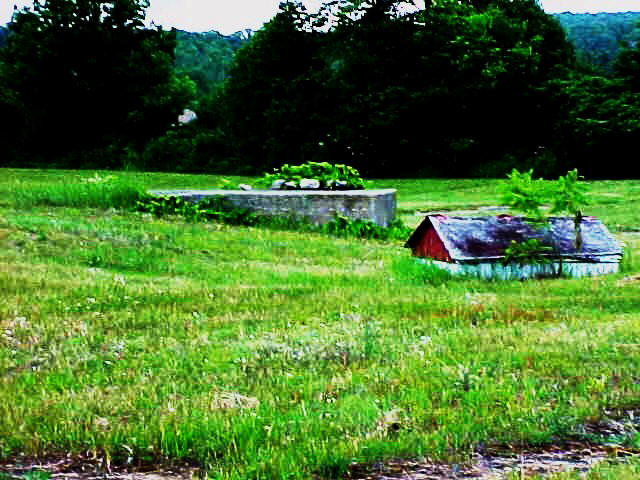
Ladabouche Photo
The well building and loading platform stand guard over Catamount's resting place. The well house is now collapsing.
The track
was completely built in an unbelievably short space of weeks in the Spring of
1965. Most tracks of the previous era had - if anything - a problem with too
much water on the grounds. Otter Creek Speedway, down near Vergennes [the last
NASCAR track in Vermont before Catamount] actually had not only a pond in the
infield but a small, but constant, stream of water running across the exit to
the fourth turn. Also, I recall Pico Raceway, my first track, having such a
drainage problem in the infield / pit area that even the wreckers were pulling
each other out.
Construction on Catamount was rolling to a
conclusion and even much of the paving in the grandstand area was done when -
according to Jack DuBrul - they decided to "toss in a well" Whoever the well
driller was tried multiple test drills and kept coming up dry. Finally Archie
Blackadar, soon to the Chief Pit Steward and a resident of the water dowsing
capital of Vermont - Danville, suggested bring in a dowser. He was, at first
laughed out of the place until desperation set in.
As the track was actually advertising
and getting set for opening night, one of Blackadar's neighbors was brought in,
apple branch in hand, to ply his trade in front of a number of smirking workers.
Soon, the branch wrenched towards the ground in a spot just inside the pit area
fence, towards the spectator area. In came the drilling rig which hit water soon
thereafter. The rest is history. A little red house was put over the well, and
that little shed still stands today, one of the only vestiges remaining of the
track. Beside it stands the concrete unloading pad. Back in the 1960's, a lot of
the cars came in on flatbed trucks.
The Milton Hilton
Courtesy of Steve Pecor
The Milton Hilton was that section above the stands, added to the right
of the announcer's tower, that had accomodations for the big sponsors and the
like.
In
the latter part of the life of Catamount Stadium, the movers and shakers started
to really build it up into a premier track that would rival anything on its
level of racing anywhere in the East or Canada. This is when the scoreboard came
in - something not many local tracks had then. it is also when they decided to
construct something that - today - most all the tracks feel they have to have:
luxury suites.
Quicky nicknamed "The
Milton Hilton" by Curley or Squier, the building would house four suites for big
sponsors and other high rollers, of which Catamount had many at that time. The
Hilton was not without its exciting moments, however. About halfway through the
construction period that Spring, a local kid [whom I taught in school] decided
to get a little stimulated on wacky tobacky and drive a piece of construction on
- site equipment directly into the base of the new project.
The Hilton was made of stern stuff and survived the event only to succumb, a few
years later, to flames when the towers were used as hose practice by the local
fire department when the damned GBIC was demolishing the track as quickly as it
could.
The Indominable Jimmy Barton
Ladabouche Collection
Jim's first car of note was this pioneering six cylinder Camarao that
helped lauch Catamount's Grand American division.
The history of Catamount Stadium is loaded with
natives of Milton, VT who had - in some way - been involved there. But, few have
their memory more cherished
or who elicit the positive comments as one Jim
Barton. Tough, often ornery, and hiding a heart of gold under the gruff
exterior, Jim was a man whom I can say proudly was a close personal friend
during his years when he still lived in town. Typical Jim was, one night,
knocking a protesting Red Rosenfield flat on the ground and then later, the same
night, lending the Massachusetts second generation driver tools and help.
When Jim and brother, Rick, first started out in the Flying Tigers around 1966,
they couldn't always keep a tow vehicle operational. Seeing as the yet - to - be
- completed Interstate 89 was being built beside Catamount, Jim would simply
drive his cars home on that road bed. The Barton home was also right next to the
road bed. His father ran a little quick stop by the house called the Happy
Store. I always gave Barton crap about that name because the elder Barton was
about as far from happy most of the time as one could get.
By the time of the above Camaro [a proud lettering job of mine] he had a great
Dodge pickup, with loud lake pipes, to haul his cars. But, one night, the Dodge
broke down in the pits. So, Jim just drove the car home, right up US Route 7.
Jim raced on off well into the '90's when he was prematurely taken by cancer. It
was the only thing that dared try to beat him.
The Great Tower Rescue
Ladabouche Collection
The Catamount announcer's tower, in its original form sits, completed
before they even had moved the stands in from Washington, DC.
The Catamount tower was the same for years prior to
the addition of the luxury boxes in the 1980's. It and the boxes were standing
there, in the Fall of 1987, when there would be no more racing at the storied
oval. Officals of the Greater Burlington Industrial Corporation [who apparently
were going to go without sleep until they had destroyed the facility] had
offered the towers to the Milton firemen for hose practice. That must have been
a bittersweet thing as the department was full of fans, muchanics, and drivers
who loved Catamount.
Just before the
fire was to be lit, Chris Companion, still a car owner on the ACT circuit, was
allowed to take one final trip through the structure. He happened to spy a
box - not much bigger than a large shoebox - sitting under a bench in the
announcer's stand. He discovered it was full of hundreds of photgraphs; so, he
grabbed it and carried it out. The materials were apparently used by Rene
LaBerge and the Catamount program staff in putting out that great magazine for
each race. It had worked on that publication and recoginzed many of the
materials. It saves a lot of history for us to enjoy [and work with].
Ironically, some of the photos on this website from that day are from Stateline
Speedway, a track of the 1950's, located way down in Bennington on the New York
border. Others are old Lebanon Valley shots and some are from Fairmont Speedway,
the early '60's forerunner of Devil's Bowl. This would have all gone up in
flames were it not for the nostalgic curiosity of Chris Companion.
The Infamous Catamount Bleacher Collapse
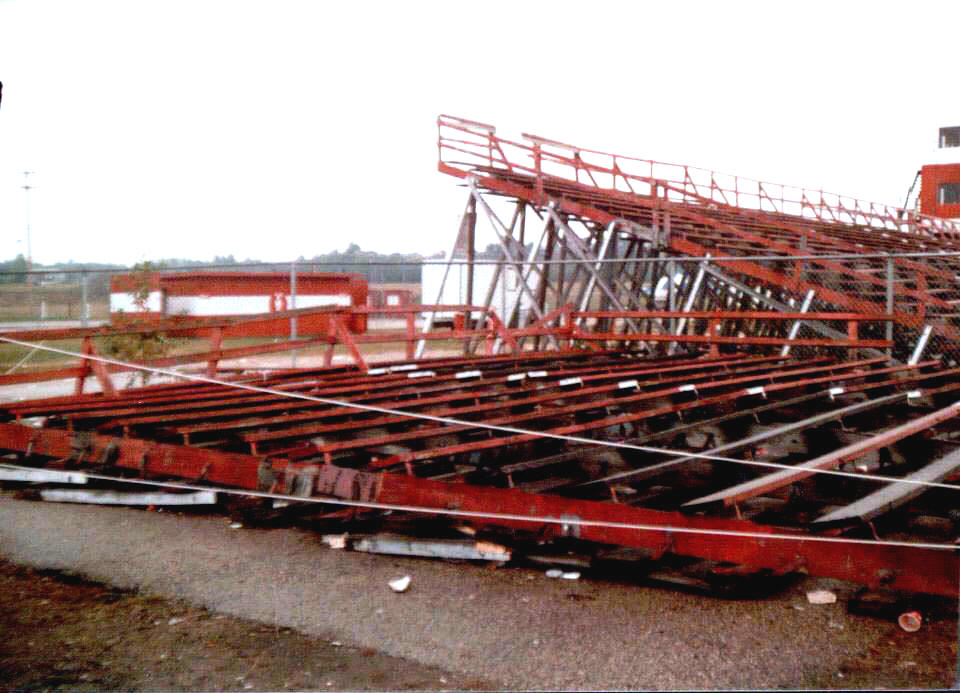
Courtesy of Andy Boright
Someone took this shot long after the program was over, as evidenced by no
people and the closed pit concession stand.
It's an oft repeated story that the the Catamount bleachers first came from the LBJ inaugural parade in Washington, D.C. in 1965 [in an ice storm] as management rushed to complete Vermont's newest and most modern race track. These bleachers - particularly the main sections - were only so high and rested on asphalt. One Saturday night, in some unusally hot weather, some of the main stands noticeably settled, and measures were taken to shore them up. Not much attention was ever paid to the pit bleachers, however.
Later on, as the track became a bigger player in the Northeast racing scene, higher bleachers were obtained from Centennial Field at the University of Vermont. The stands had been stored since UVM had dropped its football program years before. Those stands would remain stalwart until the track was sadly demolished in 1987. But one particual;r Sunday afternoon in the mid 1980's, during a feature being dominated by Robbie Crouch, the older pit bleachers decided they weren't so stalwart.
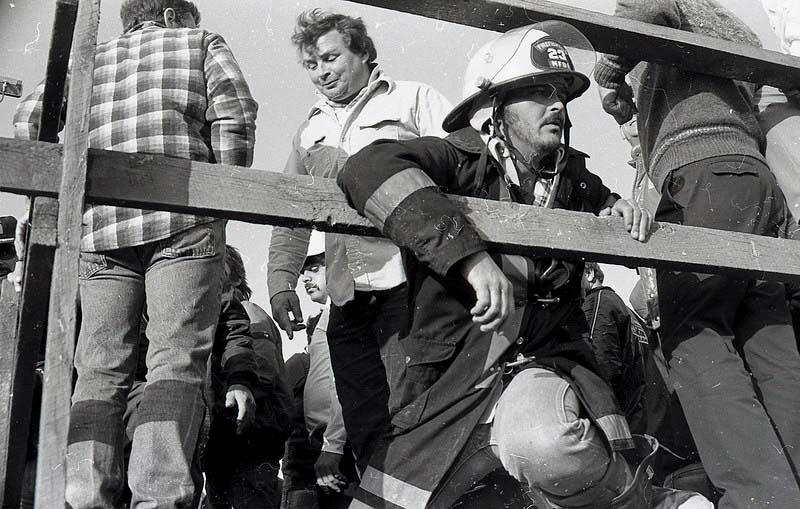
Courtesy of Cho Lee
A first responder waits among people trapped
on the top section of the collapsed pit bleachers. They would lower numerous
people to the groound.
We were crowded on, around, and in front of the pit bleachers watching the NASCAR North Tour doing its thing when a strange sound accompanied a noticeable drop downward in the stands. One single voice was heard to say, "Oh Shit !" The next thing anyone knew, the stands collapsed about halfway to the ground. People were trapped on top, some were hurt jumping off, some people had their legs trapped; it was a mess.
Local first responders were pouring in mere minutes after the race had been red flagged. Anyone in the pits who knew how to respond was on hand, helping out. When it was all over, track personnel knocked the bleachers the rest of the way to the ground and cordonned off the area. It remains the single most recalled incident for a lot of Catamount faithful.
The Here's Yer Hat ! What's yer Hurry ?
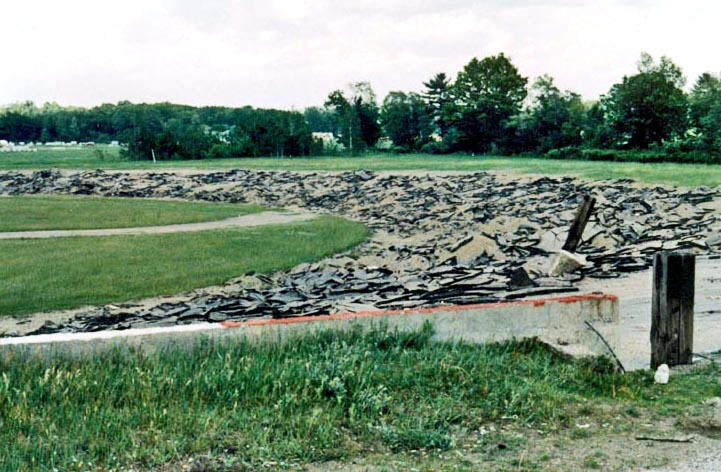
Steve Pecor or Gerry
Bergeron Photo
The track surface
was torn up less than a week after the final program there.
It wasn't bad enough that Catamount management had gotten themselves trapped ina five - year lease that the Greater Burlington Industrial Corporation refused to extend, but the corporation was so anxious to get rid of the track that they hardly waited a week to begin demolishing one of the finest short tracks in history. Maybe they thought it wa going to rise from the dead and run a race through one of its damned factories. At any rate, the fact that it is increasingly hard to recognize the venue, that doesn't stop most of us from making regualr pilgrimages to the site. I live in fear that they arfe going to plunk a building square in the middle of the infield.
Sound the Fire Bells !
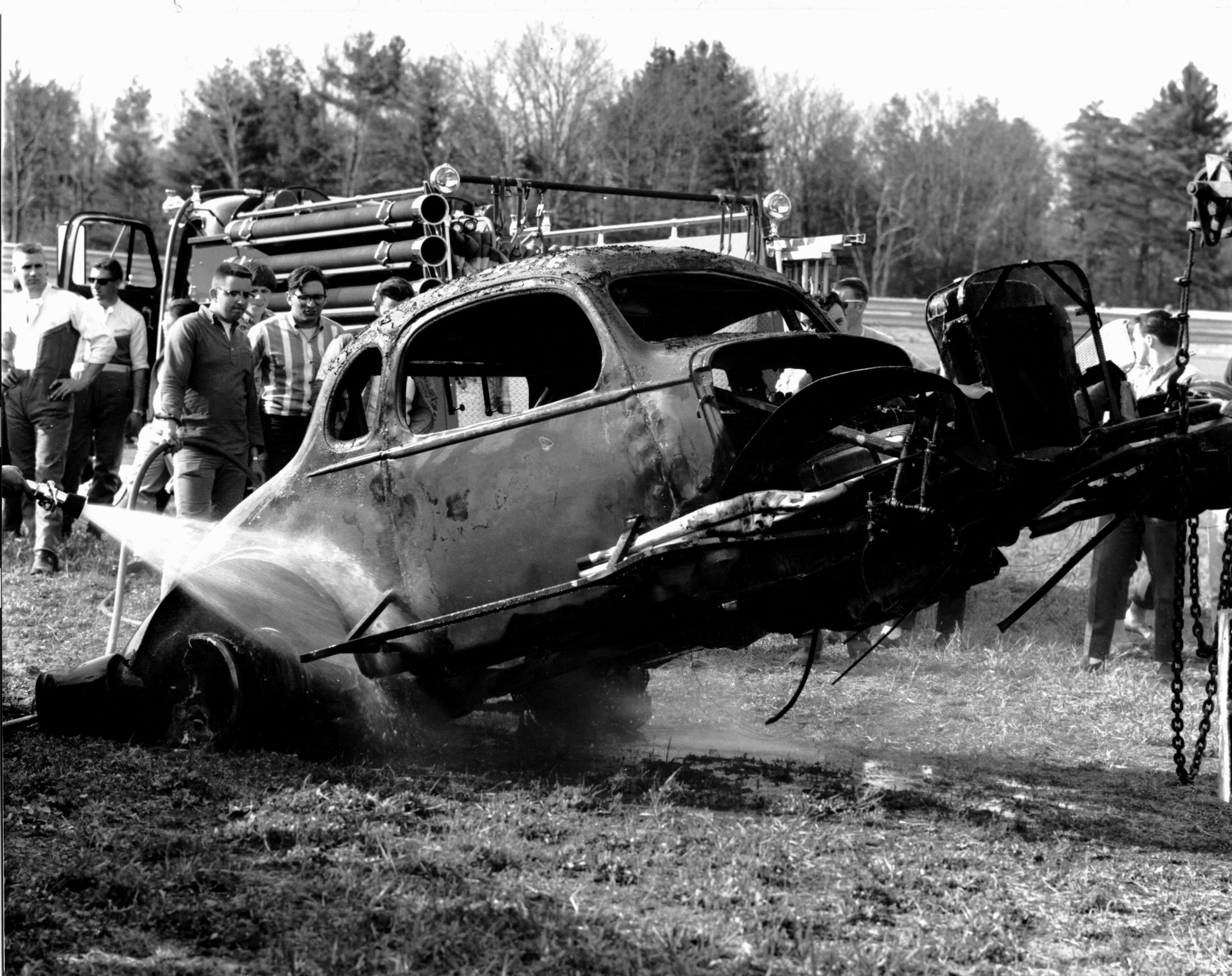
Courtesy of Cho Lee
The Dragon
brothers, wearing identical "firesuits" stand and watch as Gordon Adams and
other MIlton firemen attend to the remanants of Ray Forte's #30..
Catamount Stadium was widely held as one of the Northeast's most modern and progressive tracks - not only at its inception but for all the years of its all - too - short life. However, one thing that was none too progressive was fire safety. At the beginning, it wasn't very effective anywhere, but Catamount didn't keep a local fire truck on premises either. In the mid 1960's, Quebec driver ray Forte brought in a beautiful red '36 Chevy coupe numbered 30. For some unknown reason, the car started on fire and proceeded to quickly buirn to the ground. Having no real firefighting capabilities, Catamount had to send into Milton, which responded with a small, early '50's truck to deal with a car already burned out. Canadian guys you talk to about the incident generally subscibe to the theory that Forte was running illegal fuel, which accelerated rate of burn
As if this fire wasn't enough, I was at a race around 1969 when Ron Perry's big old red four - door '57 Chevy Flying Tiger went up in flames. This time, while the car was totally burned, the engine somehow survived. Ron mentioned to me, around 2015, that still had the engine at home. After that, the track begrudgingly went out, bought a huge fire extinguisher, and made a deal with Nordic Ford of Burlington to supply a large pickup truck to carry the behemoth extinguisher. There was always an undercurrent of rumor and conjecture that - after sitting around unused for a number of seasons - the big fire extinguisher would never had worked, The powder that is used in such things apparently has to be "Charges" every so often and few people thought it ever was. Luckily, there was never another fire of that magnitude at Catamount.
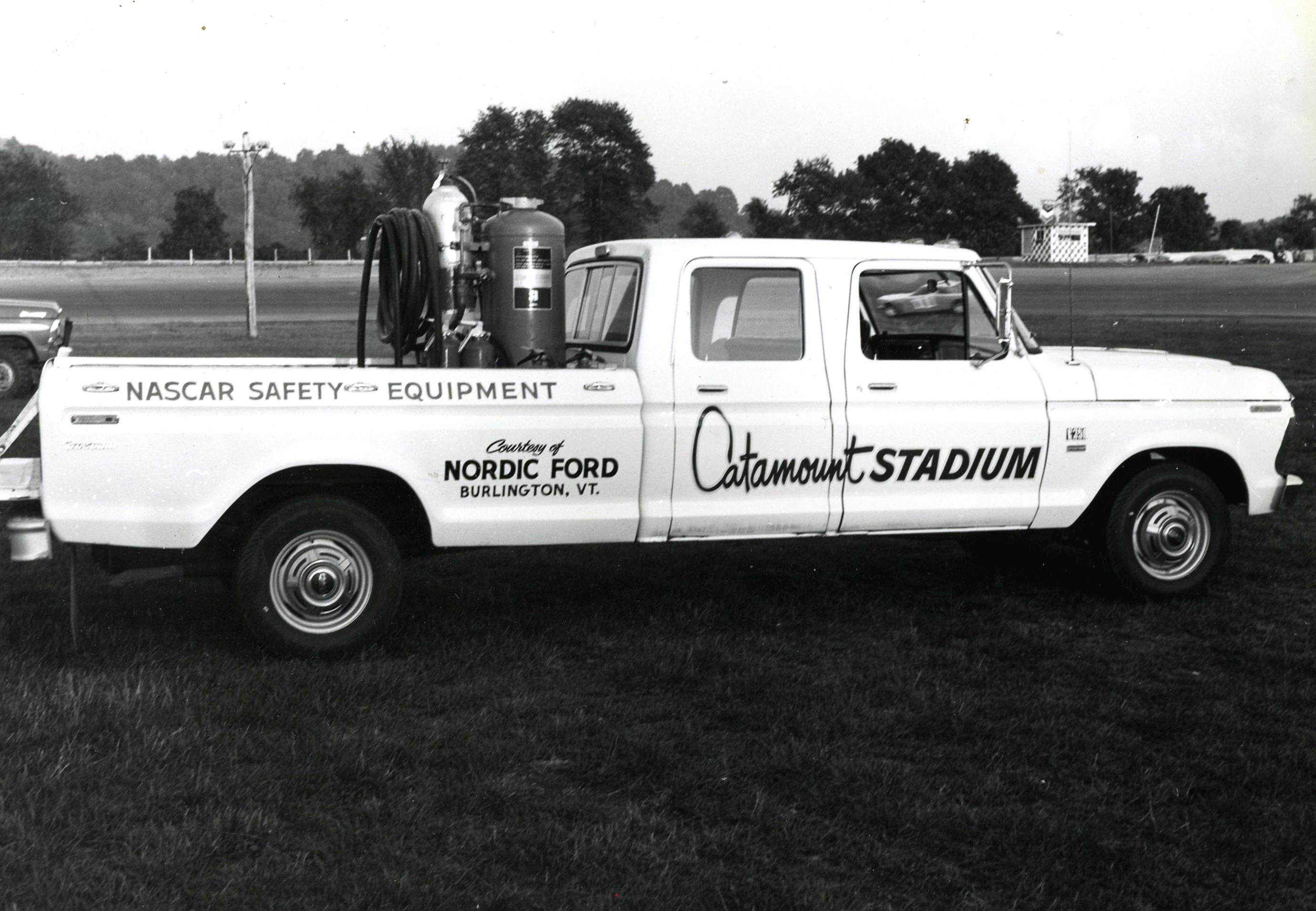
Courtesy of Paul Mascitti
The enigmatic
Catamount fire truck.